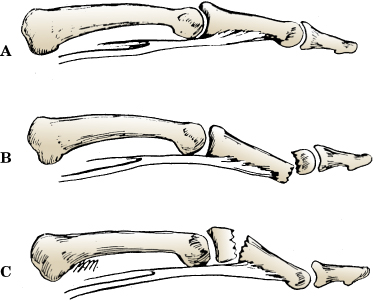(A) Lateral View, Showing the Prolonged Insertion of the Superficialis Tendon into the Middle Phalanx. (B) A Fracture through the Neck of the Middle Phalanx is Likely to Have a Volar Angulation Because the Proximal Fragment is Flexed by the Strong Pull of the Superficialis. (C) A Fracture through the Base of the Middle Phalanx is More Likely to Have a Dorsal Angulation Because of the Extension Force of the Central Slip on the Proximal Fragment and a Flexion Force on the Distal Fragment by the Superficialis.

(From CapoJT, GottschalkMB, StreubelPN, et al. Hand fractures and dislocations. In: TornettaP III, RicciWM, OstrumRF, et al., eds. Rockwood and Green’s Fractures in Adults. Vol 1. 9th ed. Philadelphia: Wolters Kluwer; 2020:1665–1770.)